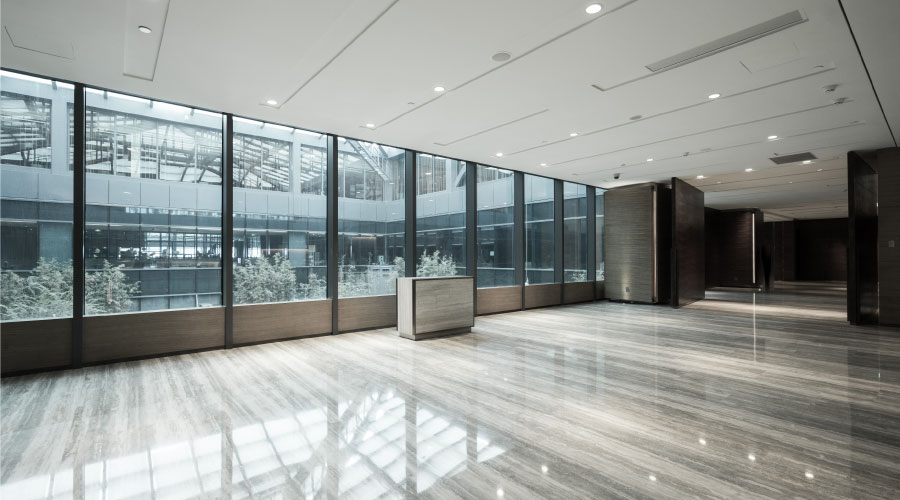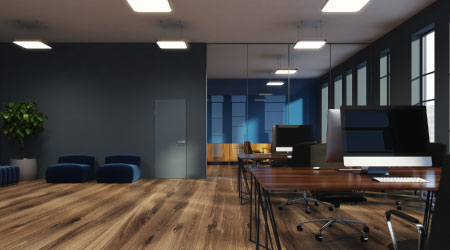New Flooring — Without Snags
Five basic tips can help the facility executive choose the right floorcovering for a space
Flooring is unavoidably high-profile. A bad flooring choice becomes a very visible problem. And because everything inside the building — furniture, cubicles, and equipment — sits on top of the floor, it is difficult and disruptive to replace. Finding the right floor product for a given space is a matter of paying attention to some basic rules.
1. Know the application
Flooring manufacturers offer a variety of products with an equally wide variety of performance characteristics. How can facility executives decide which one is best? Most critical, say experts, is knowing the application.
“My first advice is to determine the use of the space in question,” says Ann Marie Jackson, interior design department coordinator with Fanning Howey. “What type of traffic will it have?”
Be as specific as possible. A high-foot-traffic space might do well with either a durable broadloom or a hard surface like vinyl. But for an area with rolling-cart traffic — like a hospital corridor — rubber might be a better option.
Jackson poses a separate but related question: “What type of soil will the area be attracting?”
An elementary-school corridor and a hallway in a corporate office might both see moderate to heavy foot traffic. But the likelihood of spills and tracked-in dirt in a school setting must be taken into account.
In office spaces, it is important to consider issues like access to underfloor cabling. If cabling will be rerouted frequently to accommodate growth or churn, carpet tile may be a good option. Individual tiles can be lifted and replaced without disrupting the entire area.
“People used to be concerned about tile because it created a checkerboard look, but manufacturers have really heightened the designs,” says Julie Gauthier, associate, Kirksey Associates. “It doesn’t even look like tile anymore.”
2. Consider life-cycle factors
A good flooring choice for a given application is by definition a durable one — one that won’t wear out faster than anticipated. The length of that anticipated life, however, depends on the particular space. The most durable products can cost more, so it’s important to identify how long the flooring is expected to last.
“A carpet in a college dorm room might not be expected to have a long life, so paying for very high durability might not make sense,” says Maren Engelmohr, architect, Mackey Mitchell.
The same holds true for corporate applications in which lease terms are limited to five or 10 years. If the carpet will be replaced at the end of the lease, there is no sense in selecting a product billed to last 30 years.
For the majority of applications, however, durability is a critical consideration.
“Once the flooring is installed in a hospital, they can’t have downtime to replace it,” says Engelmohr. “They need something that is going to last long, wear well and be easy to clean.”
Regardless of the product, experts advise that in a majority of cases flooring should be regarded as a long-term investment. That means considering life-cycle costs, not just first costs.
“I would always recommend spending a little more on a product that is going to last longer,” says Gauthier. “The extra cost initially is far preferable to the expense and disruption of having to replace it too soon.”
3. Keep up appearances
Experts agree that, if a flooring product is well matched with its application, no single factor affects its performance more than maintenance. Therefore it is important to be realistic about a facility’s maintenance resources when making a flooring decision. While vinyl flooring is an inexpensive and practical choice from most perspectives, its stripping and waxing requirements may make it untenable for an organization with a limited janitorial staff. Even in schools — a classic application for vinyl flooring — other options may perform better from a life-cycle cost perspective if budget cuts have reduced maintenance resources beyond a certain point.
Carpet, although it is among the easiest of flooring products to maintain, requires consistent care, generally in the form of daily vacuuming, weekly spot-cleaning and quarterly water extraction.
“A lot of people want a carpet that will not show soil,” says Diane Schroeder, senior design leader, Nelson. “That’s fine, but the soil is there whether it shows or not and eventually it is going to ruin the carpet. So people need to understand that if they can’t commit to proper maintenance, no product’s performance is going to be up to their expectations.”
Another key factor in a floor’s long-term performance, say experts, is the quality of its installation.
“You can end up with ripples or split seams, and if that happens you are in big trouble,” says Schroeder.
To avoid installation nightmares, Schroeder recommends that the facility executive work closely with the designer or architect to choose an installer with a proven track record — which usually is not the cheapest option.
“We really put a prospective new installer through the paces in an interview,” she says. “You have to. No matter how good a carpet is, it can fail if the installation is bad.”
4. Think long-term
For all the emphasis on durability, experts say it is important to evaluate the life-cycle of a flooring product from other perspectives as well. Chief among these: aesthetic life.
“Long life is an aesthetic concept too,” explains Tim Nichols, director of design, interiors, HOK. “You can’t jump to the trendiest product for a space that’s going to remain relatively unchanged for the next 20 years. That look will quickly date itself.”
Another key issue in the overall life of a flooring product is what happens when it finally does wear out. More and more manufacturers offer products made wholly or in part from recycled materials, and offer reclamation programs to keep their products out of the landfill. It’s an issue, experts say, that needs to be addressed from the outset. Doing so is the joint responsibility of the architect, the facility executive and, under the terms of some leases, the tenant as well.
Do recycled content and other sustainability measures cost more? Not necessarily.
“If you are dead-set on the absolute cheapest product, you might not be able to get the sustainability aspect,” says Engelmohr. “Manufacturers have jumped on board and you can get sustainable products that are comparable in price.”
Sustainably manufactured products may also have improved indoor air quality. That means happier occupants, especially in schools, hospitals, offices and other facilities where indoor air quality is a major concern.
5. Don’t make it last-minute
Interior finishes like flooring are sometimes regarded as afterthoughts. But leaving flooring decisions until the last minute is a mistake that can lead to extra costs and other problems.
“Flooring choices need to be made alongside decisions like whether to have a raised floor,” says Engelmohr. “If you’re going to have a terrazzo floor, for instance, you need to know that when you pour the slab for the base of the building so you can allow for the thickness of the product. Even if you don’t know exactly which product you are going to use until later, you need to decide about the type of flooring early on.”
A good starting point for preliminary planning is deciding what is affordable. Break the overall budget down according to elements of the interior. “Once you know what you have to work with for the walls, ceiling and floor, you can decide where your priorities lie,” HOK’s Nichols says.
In most cases, say experts, a flooring investment warrants priority consideration over other interior finishes. “The floor can really set the tone of the design,” says Engelmohr.
Abigail Gray, a contributing editor for Building Operating Management, is a writer who specializes in facility issues. She is the former editor of EducationFM magazine.
Related Topics:











